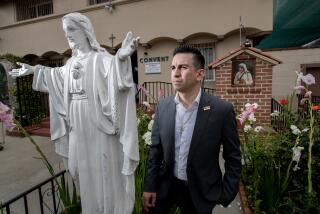Safe-Sex Floats at Rio Carnaval Spur Clash With Church
- Share via
RIO DE JANEIRO — Millions of exuberant revelers poured onto the streets of Brazil on Monday as the country’s biggest block party, the annual bacchanal known as Carnaval, kicked into high gear amid marching bands, men dressed as brides and a kerfuffle over sex on parade.
From Salvador in the east to this famous beachside city farther south, Brazilians took advantage of a national holiday Monday to press on with celebrations that began over the weekend and will stretch through most of Wednesday, when the Christian period of Lent begins.
Here in Rio, all eyes are riveted on the lavish late-night parades in the Sambodrome stadium, where top samba clubs display spectacular floats and dancers wear elaborate costumes -- or hardly anything at all -- in a competition for Carnaval’s coveted championship.
The talk of the town has been the entry from the Grande Rio club, whose effort to put the carnal in Carnaval has provoked the wrath of the Roman Catholic Church. The club’s theme, “Let’s put on a condom, my love,” celebrates the joys of safe sex and has earned the unusual approval of the United Nations’ AIDS organization.
But the archbishop of Rio declared his outrage over two floats with huge figures depicting couples practicing techniques from the Kama Sutra and Adam and Eve doing what, according to the Bible, gave rise to the rest of humankind. The archdiocese called the figures “indecent images” that would “disturb the peace” of Carnaval, which is invariably rampant with nearly naked men and women gyrating to the deafening sounds of samba.
The controversy highlighted the contradictions that reign in Brazil during Carnaval -- as well as the rest of the year. Bowing to the church’s objections in this predominantly Catholic nation, state officials ordered Grande Rio to cover up the offending sculptures. Yet the federal health ministry launched a condom giveaway campaign during Carnaval, and many Brazilians were left wondering what the fuss was about -- especially residents of Rio, a city that enjoys its reputation for skin and sin.
Grande Rio’s artistic director, Joaosinho Trinta, dismissed accusations of lewdness.
“I’m a 70-year-old artist who doesn’t need to resort to pornography,” said Trinta, who has won more titles than any other Carnaval designer.
His last big run-in with the Catholic Church occurred in 1989, when he designed a float with a replica of the landmark Christ the Redeemer statue that towers over the city. In Trinta’s version, Christ was dressed up as a beggar.
He was told to remove the sculpture. Its appearance in the parade smothered under black plastic has become an indelible moment in Carnaval history, to the church’s dismay.
Trinta appeared to go for the same effect early Monday during Grande Rio’s 80 minutes under the floodlights at the Sambodrome. Rather than place gold ribbons over strategic parts of the amorous figures, as Grande Rio officials hinted they would do, they covered the sculptures with plastic tarps and a ribbon declaring in large letters, “Censored.”
Dancing behind the first offending float was a troupe of men in orange-feathered headdresses with female mannequins strapped around their waists.
Then the costumed baianas, a wing traditionally composed of elderly women from the samba club’s community, spun into view. Sweet-looking grandmothers, some with eyeglasses hanging on straps around their necks, sang, “Kiss me on the mouth, make my dream come true.” A few dabbed their wrinkled foreheads with towels as they twirled in hoop skirts with medallions showing a couple in sexual congress.
The parade passed without visibly shocking any of the tens of thousands of spectators, who may have been difficult to offend after hearing a samba club singer shout, “I want to see everybody naked!”
Rio’s law-enforcement agencies have been out in force to crack down on the violence -- in addition to the indecency -- that often plagues the merrymaking. Police have erected observation towers, occupied poor neighborhoods near the Sambodrome and put more than 3,200 officers on patrol in the area.
Officials want nothing to mar an event that has drawn 400,000 tourists to the city, 20% of them from abroad. They include the passengers of the Queen Mary II, the world’s largest cruise ship, which docked here Saturday on its maiden voyage.
Last year, authorities deployed army troops on Rio’s streets during Carnaval after bandits with suspected ties to organized crime set buses ablaze, closed down shops and detonated bombs on the eve of the festivities in some of the city’s most fashionable districts.
More to Read
Sign up for Essential California
The most important California stories and recommendations in your inbox every morning.
You may occasionally receive promotional content from the Los Angeles Times.













